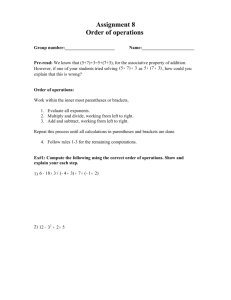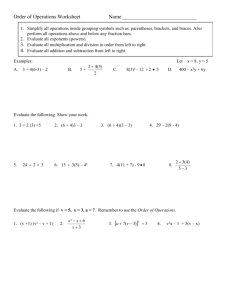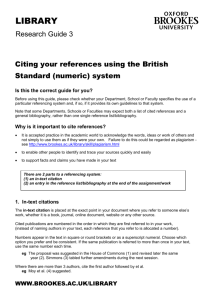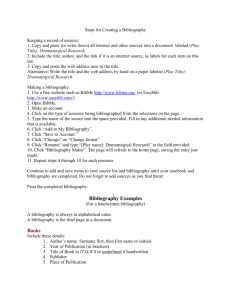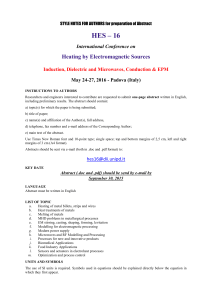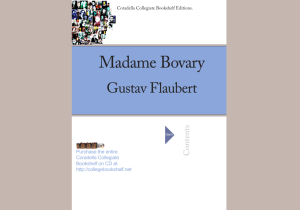Essay Writing: Referencing Guide - Birkbeck University
advertisement
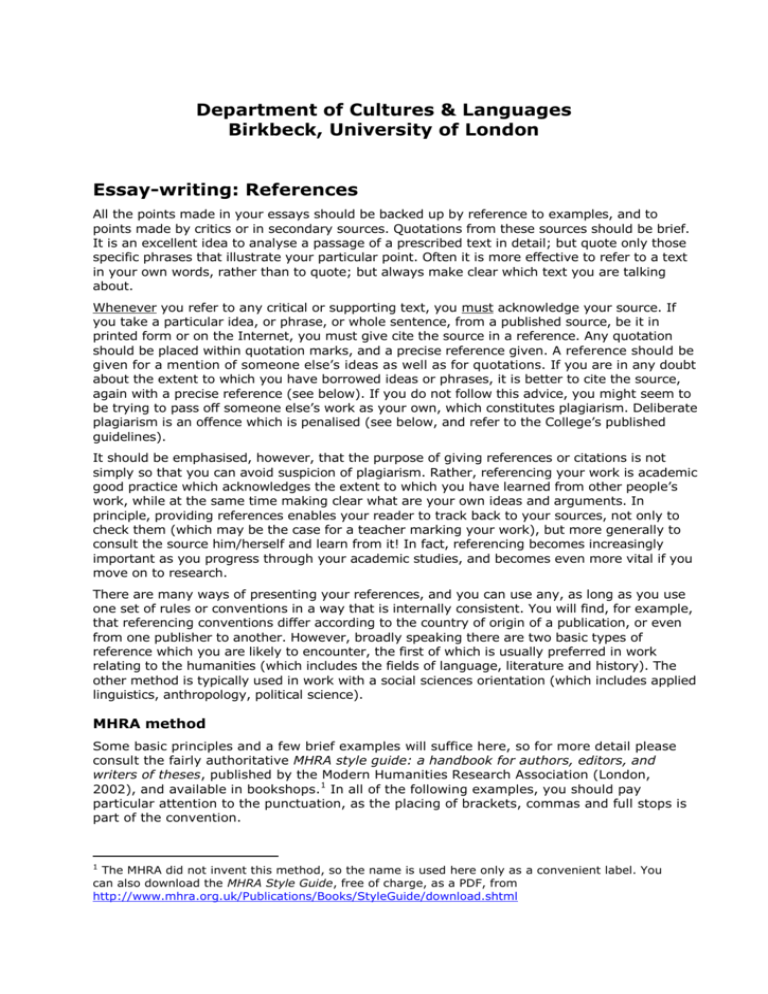
Department of Cultures & Languages Birkbeck, University of London Essay-writing: References All the points made in your essays should be backed up by reference to examples, and to points made by critics or in secondary sources. Quotations from these sources should be brief. It is an excellent idea to analyse a passage of a prescribed text in detail; but quote only those specific phrases that illustrate your particular point. Often it is more effective to refer to a text in your own words, rather than to quote; but always make clear which text you are talking about. Whenever you refer to any critical or supporting text, you must acknowledge your source. If you take a particular idea, or phrase, or whole sentence, from a published source, be it in printed form or on the Internet, you must give cite the source in a reference. Any quotation should be placed within quotation marks, and a precise reference given. A reference should be given for a mention of someone else’s ideas as well as for quotations. If you are in any doubt about the extent to which you have borrowed ideas or phrases, it is better to cite the source, again with a precise reference (see below). If you do not follow this advice, you might seem to be trying to pass off someone else’s work as your own, which constitutes plagiarism. Deliberate plagiarism is an offence which is penalised (see below, and refer to the College’s published guidelines). It should be emphasised, however, that the purpose of giving references or citations is not simply so that you can avoid suspicion of plagiarism. Rather, referencing your work is academic good practice which acknowledges the extent to which you have learned from other people’s work, while at the same time making clear what are your own ideas and arguments. In principle, providing references enables your reader to track back to your sources, not only to check them (which may be the case for a teacher marking your work), but more generally to consult the source him/herself and learn from it! In fact, referencing becomes increasingly important as you progress through your academic studies, and becomes even more vital if you move on to research. There are many ways of presenting your references, and you can use any, as long as you use one set of rules or conventions in a way that is internally consistent. You will find, for example, that referencing conventions differ according to the country of origin of a publication, or even from one publisher to another. However, broadly speaking there are two basic types of reference which you are likely to encounter, the first of which is usually preferred in work relating to the humanities (which includes the fields of language, literature and history). The other method is typically used in work with a social sciences orientation (which includes applied linguistics, anthropology, political science). MHRA method Some basic principles and a few brief examples will suffice here, so for more detail please consult the fairly authoritative MHRA style guide: a handbook for authors, editors, and writers of theses, published by the Modern Humanities Research Association (London, 2002), and available in bookshops.1 In all of the following examples, you should pay particular attention to the punctuation, as the placing of brackets, commas and full stops is part of the convention. 1 The MHRA did not invent this method, so the name is used here only as a convenient label. You can also download the MHRA Style Guide, free of charge, as a PDF, from http://www.mhra.org.uk/Publications/Books/StyleGuide/download.shtml The title of a book or journal is always given in italics (e.g. Madame Bovary, French Studies), while the title of a journal article or a chapter in a book is given in roman script, enclosed within single speech marks (e.g. ‘Marivaux ... le double registre’, ‘Individual differences in second language acquisition’). For books, you should always give the following information, where it is relevant, in this order: author(s), title, editor or translator, series, edition, number of volumes, details of publication (i.e. place of publication, name of publisher, date of publication, in brackets), page numbers referred to: Julia Kristeva, Pouvoirs de l’horreur: Essai sur l’abjection (Paris: Seuil, 1980) La Cinquième République, edited by Dominique Chagnollaud & Jean-Louis Quermonne, 4 vols, rev. ed. (Paris: Flammarion, 2000), vol.3, p.130. Albert Camus, The First Man, translated by David Hapgood (London: Penguin, 2001) [orig. Le Premier homme, 1995]. For articles you should give: author(s), title, title of journal, volume number, year(s) of publication (in brackets), first and last page numbers, (and for precise references, page number(s) in brackets, and preceded by p. or pp.). Henri Coulet, ‘État du genre romanesque en France [1690-1715]’, Studies on Voltaire and the Eighteenth Century 320 (1994), 41-69 (pp.51-3). Patrick ffrench, ‘The Memory of the Image in Chris Marker's La Jetée’, in French Studies 59 (2005), 31-37. For book chapters (e.g. in multi-authored works), give full book details (as above), preceded by author, title and ‘in’, and followed by page numbers for the whole chapter (with pp.), and perhaps a more precise reference: Frederick Cooper, ‘The Dialectics of Decolonization’, in Tensions of Empire. Colonial Cultures in a Bourgeois World, ed. by Frederick Cooper & Ann Laura Stoler (Berkeley: University of California Press, 1997), pp. 406-435 (p.420). For articles in newspapers and magazines, the following information (only) is needed: author, article title, journal, page number(s): Neal Ascherson, ‘As the Queen goes to France this week, the Entente Cordiale remains a fractious, fragile alliance’, Observer, 4 April 2004, p.21. For internet sources, you should provide, in addition to appropriate information on author, title, etc, the complete URL of the resource (in angle brackets < >) and the date on which the resource was consulted: ‘Le site Facebook vend le profil de ses internautes aux publicitaires’, Le Monde, 10 November 2007, <www.lemonde.fr> [accessed 11 November 2007]. The examples given are all suitable for using in footnotes, but after you have given a reference once, subsequent references to the same source should be abbreviated in the shortest intelligible and unambiguous form, e.g.: Cooper, ‘Dialectics’, p.430. Chagnollaud & Quermonne, La Ve République, vol.3, pp.45-61… OR Chagnollaud & Quermonne, vol.3, pp.45-61. These abbreviated references should also be placed in footnotes, though they may, if you prefer, stand in brackets in the body of your text. In particular, you may wish to abbreviate the details of prescribed texts which you are analysing, e.g. (Flaubert, Madame Bovary, p.162) OR (Madame Bovary, p.162) OR (p.162). In these latter examples your bibliography should make plain which edition you are using, so that your references may be checked (especially important for detailed examples), e.g.: Flaubert, Gustave, Madame Bovary (Paris: Garnier-Flammarion, 1966) At the end of your essay, irrespective of the form of references in your text, you should give a full bibliography, i.e. a list of references of all the texts referred to or consulted, in alphabetical order by name of (first) author or editor (or by title, excluding Le/la, The/A, etc.). Do not include works which you did not use for this particular essay, and you do not need to cite dictionaries, e.g. Le Petit Robert. The form of references in a bibliography is much the same as for footnotes, but the (first) author’s name should be given surname first, and editors’ names should appear before the title of edited works. (Note the absence of full stops at the end of each entry): ‘Battle of Algiers, The’, <en.wikipedia.org> [accessed 11 November 2007] 2 Bettelheim, Bruno, The Uses of Enchantment: the Meaning and Importance of Fairy Tales (Harmondsworth: Penguin, 1991) Hobsbawm, Eric, and Terence Ranger, eds, The Invention of Tradition (Cambridge: Cambridge University Press, 1983) By now, you may see the point (or part of the point) of using a word-processing application on a computer in order to produce your work! Indeed, specialised software exists which allows you to process references, for example when they are copied from electronic sources such as library catalogues. Author/date or ‘Harvard’ method The underlying principles remain the same for this method, which is favoured for writing in the social sciences, where references tend to be more frequent, and/or where there is more discussion of others’ ideas or theories. The chief difference between this method and the ‘MHRA’ method is that references are always given in the body of the text (i.e. not in a footnote), in brackets, in the form (Author surname, date of publication, page ref.), e.g. ‘(Cooper, 1997, 430)’. Where the author’s name is mentioned in the text, it is omitted from the reference, e.g. ‘Smith (1999) contends that…’ or ‘Smith’s (1999, 251) argument that…’. These abbreviated references must then be followed up with a full reference in the bibliography, which is broadly similar to the entry in a MHRA-type bibliography, except that the date immediately follows the author’s name. Otherwise, various conventions may be followed, e.g.: Chakrabarty, Dipesh (1992). ‘Postcoloniality and the Artifice of History: Who Speaks for ‘Indian’ Pasts?’, Representations, 37, 1-26 Lightbown, Pat, & Nina Spada (1999). How Languages are Learned, Oxford, Oxford University Press Where there are two or more publications by a given author in a single year, these should be listed (in the bibliography and in the text) as, e.g. 1997a, 1997b, etc. 2 This example should not be taken as encouragement to use Wikipedia extensively: this is a valuable but not entirely reliable source, as it may be updated by any individual user.


